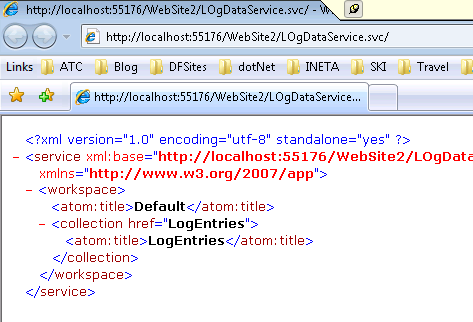I was experimenting with creating data services from IQueryables. Rather than use the canonical example of creating a set of 3 person objects on the fly and exposing them, I decided to create a service for my application log. (Not something I plan to expose to the web, just a learning tool ;-)).
I created a wrapper class for the System.Diagnostics.EventLogEntry class because I needed to have an ID field that could be read. Thanks to Jonathan Carter’s blog post, I knew that there was no property of the real class that would work, so I needed to create my own class with a valid field for a discoverable identity property.
Having done this, I tested my service which worked just fine:

Since I knew there are a LOT of entries in my application log file (I don’t have a sysadmin to do that maintenance for me) I thought it would be smart to filter the entries by adding /LogEntries?$top=10 to the URI. I wasn’t sure how Vista would handle that and wasn’t shocked to see in the debugger that the filtering was going to be left up to the dataservice:

It’s definitely a huge advantage to be able to expose (or interact with) any IQueryable through Astoria, but don’t forget that it’s the database that has the query processor. In this case, I was returning 23,000 items to my service to be processed.
If I do the same filter to a service that exposed a database via an Entity Data Model, for example Northwind
http://localhost:55176/DataServices/NWDataService.svc/Categories?$top=10
the query is processed by the Entity Frawework and the filter is part of query sent to the database:
SELECT TOP (10)
[Extent1].[CategoryID] AS [CategoryID],
[Extent1].[CategoryName] AS [CategoryName],
[Extent1].[Description] AS [Description],
[Extent1].[Picture] AS [Picture]
FROM [dbo].[Categories] AS [Extent1]
ORDER BY [Extent1].[CategoryID] ASC
Only 10 items are returned for the service to process.
LINQ to SQL will do the same … i.e. create a filter query that gets sent to the database.
Yes exposing my entire un-maintained application event log is not a real-life scenario and in a real network, I might even use the nice filters that Vista provides for event logs.
But the point is just to pay attention to what you may be asking your service to do.
![]() Sign up for my newsletter so you don't miss my conference & Pluralsight course announcements!
Sign up for my newsletter so you don't miss my conference & Pluralsight course announcements! ![]()
Hey Julie,It’s to see that you’re experimenting with custom data sources for Data Services. As you say, you have to careful when you use non-database sources. In particular, you have to careful if what you’re doing is bringing in "plain" collections and using the AsQueryable() operator to turn an enumerable into a queryable object, because all the data will be brought into memory and then processed there (that’s just the way LINQ to Objects works). Note, however, that you have an option to get fancier. If your source supports some of the operations (e.g. filtering), you can write your own IQueryable translator (partial or complete) and then you’ll be as efficient as the database case…the operations will be pushed down to the data source. Of course, writing an IQueryable provider is far from a trivial task…so I would expect that the authors of non-database data sources will come up with LINQ providers for them over time.-pablo